East Pomeranian operation
The situation before the battle
The East Pomeranian operation was carried out between the large offensive of the Soviet troops in January 1945, the breakthrough of the powerful and deeply echeloned enemy defenses between the Vistula and the Oder, the defeat of the German troops in Western Poland, the withdrawal of the 1 of the Belarusian and 1 of the Ukrainian fronts on the rivers Oder and Neisse (Before the fall of Germany. Vistula-Oder operation; Part 2), surrounded by enemy groups in East Prussia (The second assault on East Prussia. Insterburg-Konigsberg and Mlavsko-Elbinga operations), The Berlin operation of the 1 and 2 of the Belarusian and 1 of the Ukrainian fronts. In fact, the East-Pomeranian operation arose in the course of the Vistula-Oder and East Prussian operations and became the continuation of the Red Army's grand winter offensive.
By the beginning of the operation on the right strategic flank of the Soviet-German front, a peculiar and complex situation had developed. In the western part of Latvia, the Army Group Kurland was surrounded. During the first phase of the East Prussian operation, the East Prussian enemy grouping was divided into three groups, including the Königsberg garrison. The Germans continued to control Eastern Pomerania, where they concentrated a large grouping of troops to deliver a counterattack along the flank and rear of the 1 Belorussian Front, which threatened Berlin.
The troops of 1 of the Byelorussian Front, breaking through the enemy defenses on the Vistula, withdrew the forces of the center's armies to the Oder River and, forcing this last powerful water line on the outskirts of the German capital, occupied bridgeheads on its left bank in the Kustrin and Frankfurt an der Oder areas. The armies of the 1-center of the Byelorussian Front continued the struggle to expand the bridgeheads on the west bank of the Oder and to destroy the German garrisons in Kustrin and Frankfurt. The right wing of the front solved the task of covering the flank and rear from the blow of the Pomeranian grouping of the enemy.
In early February, 1945 between the troops of the right wing of the 1 of the Belarusian Front and the troops of the 2 of the Belarusian Front, the main forces of which fought heavy battles surrounded by the enemy forces of the East Prussian group, formed a large 150-kilometer gap. It was covered by insignificant forces of the troops of the right flank of the 1 of the Byelorussian Front. Without the defeat of the German troops in Pomerania, attacking the Berlin sector was extremely dangerous.
The command of the 1 of the Byelorussian Front, in accordance with the prevailing situation on the right flank, was forced to take urgent measures to protect the troops from the flank attack of the Wehrmacht’s Eastern Pomeranian group. The defeat of the enemy troops in Eastern Pomerania allowed the right-wing army to withdraw to the line of the Oder River and continue the offensive in the Berlin direction. The overall military-political situation demanded an immediate solution of the task of destroying the German forces in Eastern Pomerania and eliminating the surrounded group in the Konigsberg area.
The task of eliminating the East Prussian group was assigned to the troops of the 3 of the Byelorussian Front. He was strengthened by transferring to him four armies of the right wing of the 2 of the Byelorussian Front. To the 2 of the Belorussian Front, the Supreme High Command instructed the remaining forces to defeat the enemy's East Pomeranian grouping and occupy all of Eastern Pomerania, from Danzig (Gdansk) to Stettin (Szczecin), leaving for the Baltic coast. Rokossovsky's armies launched the 10 February 1945 offensive, with little or no training.
Thus, the initial task of eliminating the East Pomeranian grouping of the enemy was to be resolved by the 2 of the Byelorussian Front under the command of Konstantin Rokossovsky. However, Rokossovsky's troops were exhausted by fierce and long battles (about a month) in East Prussia, the transfer of four armies to the 3 of the Byelorussian Front. The offensive began almost without preparation and took place in the harsh conditions of the coming spring thaw in the wooded and marshy area. As a result, the offensive of the troops of the 2 of the Byelorussian Front developed slowly and soon stalled. German troops not only held back the 2 of the Belarusian Front, but also continued their stubborn attempts to break into the back of the 1 of the Belarusian Front, building up the strength of the Pomeranian grouping.
Therefore, the Supreme Command decided to bring in the troops of the 1 Belorussian Front under the command of Georgy Zhukov to liquidate the East Pomeranian grouping. The headquarters instructed the forces of the right wing of the 1 of the Byelorussian Front to prepare a strike in the north direction in the general direction to Kolberg. Zhukov’s troops, reflecting the stubborn and fierce attacks of the German troops trying to break through the defenses of the right wing of the 1 of the Belorussian Front east of Oder, and go to the rear of the grouping of Soviet troops aimed at Berlin, simultaneously prepare a strike to destroy in cooperation with 2 of Belorussky front East Pomeranian grouping of the enemy. Zhukov's troops were to go on the 24 offensive in February.
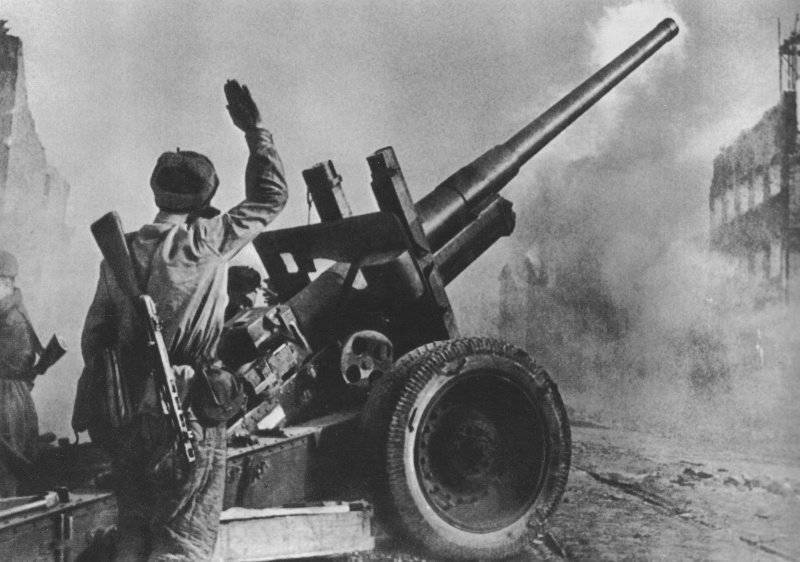
Soviet gunners firing X-NUMX-mm A-122 howitzers on Dantzig Street. Photo source: http://waralbum.ru/
Operation plan
Before the troops of the 1 Belorussian Front joined the battle, the 2 Belorussian Front armies of February 8 were instructed to launch an offensive center and left wing to the north and reach the line of the mouth of the February 20. Wisla, Dirschau, Butov, Rummelsburg, Neusthettin. At the second stage of the operation, the 1-th Belarusian Front was to receive a fresh 19-th army, advancing to the west, in the general direction of Stettin and freeing Danzig and Gdynia on the right flank. As a result, Rokossovsky’s troops were to occupy the whole of Eastern Pomerania and the Baltic Sea coast.
At the first stage of the operation, the 65th Army was supposed to advance from the bridgehead on the Vistula in the north-west direction, to Chersk and then Byut. The 49th Army received the task of developing an offensive towards Baldenberg, the 70th Army with one tank and one mechanized corps - to take possession of the Schlauch, Preuss-Friedland border, and then move in the general direction to Tempelsburg. To strengthen the strike of the left flank, the 3rd Guards Cavalry Corps received the task of occupying the area of Chojnice, Schlachau, and then attacking Rummelsburg and Baldenberg.
However, for a number of objective reasons, the 2 Belorussian Front could not independently solve the strategic task of freeing Eastern Pomerania from Hitler’s troops. Therefore, Zhukov’s army was connected to the operation. The 1 Belorussian Front was supposed to solve several tasks during this period: 1) to repel attacks from the East Pomeranian group that attempted to break through to the rear of the Soviet grouping concentrated for an offensive in the Berlin direction; 2) on the elimination of the surrounding enemy groups in the Poznań, Schneidemül, Deutsch-Krone and Arnswalde areas; 3) to destroy the enemy’s strong garrisons on the right bank of the Oder in the districts of the cities of Kustrin and Frankfurt an Oder; 4) for retaining and expanding bridgeheads captured on the west bank of the Oder. In addition, the front was preparing to continue the attack on Berlin. As the troops of the 2 of the Byelorussian Front advanced north-westward, the forces of the 1 of the Byelorussian Front holding defenses in the Pomeranian direction were released and, moving into its second echelon, they advanced to the Berlin direction.
Now the 1 Belorussian Front was hooked to the elimination of the enemy’s Pomeranian grouping. This decision of the Stavka was due to the fact that the troops of the 2 of the Byelorussian Front, because of the increased resistance of the enemy forces, halted the offensive. The German High Command continued to strengthen the Vistula Army Group, trying to prevent a Soviet offensive against Berlin. For this, the Germans formed a powerful grouping in Eastern Pomerania, which hung over the flank of the 1 of the Byelorussian Front and did not allow it to go on the offensive in the Berlin direction. With the success of the Eastern Pomeranian counteroffensive, the Germans hoped to eliminate the successes of the January offensive of the Soviet forces between the Vistula and the Oder. In addition, while keeping Eastern Pomerania behind them, the Germans retained the possibility of withdrawing their troops from East Prussia and evacuating the Courland group.
The Soviet Bet, in order to end the enemy grouping in Eastern Pomerania as soon as possible and continue the attack on Berlin, decided to throw the forces of two fronts into battle. 17 and 22 in February. The headquarters instructed the commanders of the 1 and 2 Belorussian fronts to conduct a further offensive. The overall plan of the operation was to strike the adjacent flank of the 2 and 1 of the Belorussian fronts in the general direction of Neusthettin, Kozlin, Kohlberg, and dissect the enemy grouping with the general right wing to the west to Oder, and the left wing to the east to Gdansk, destroy the German troops.
Rokossovsky decided to the left flank of the front, where the 19-th army was withdrawn, reinforced by the 3-th Guards Tank Corps, to strike at Kozlin. The left wing of the front had to go to the sea, and then turn east and advance on Gdynia. The troops of the right wing and the center of the front — the 2 th shock, the 65 th, 49 th and 70 th armies, continued to advance in the northern and northeastern directions, on Gdansk and Gdynia. They were supposed to finish off the German grouping, surrounded by the 19 th army.
The command of the 1 of the Belarusian Front 20 February decided to first go to a tough defense and for several days (until 25-26 of February) to bleed the enemy's attack forces, advancing from the Stargard area, and then go on a powerful counterattack. For the solution of this task, the armies of the right wing of the front were attracted - the 61-I and 2-I Guards Tank armies, and additionally the 1-I Guards Tank Army from the second echelon. By the beginning of the attack, the 3 th shock army was also deployed. The main blow was struck in the general direction to the north and north-west, to Kolberg and Cummin. Auxiliary strikes were inflicted by the troops of the 1 Army of the Polish Army on the right flank and the 47 Army was on the left flank, in the direction of Altdamm.
For the fastest possible breakthrough of the enemy’s defense and the development of high rates of advance, Zhukov planned to throw two tank armies into battle on the very first day of the front. The troops of the 1-th Guards Tank Army were given the task of occupying the Vangerin, Dramburg area, then advancing in the general direction towards Kohlberg, towards the troops of the 2-th Belorussian front. The troops of the 2 Guards Tank Army were to advance in a northwesterly direction, at the beginning of the offensive, seize the area of Freienwalde and the Masses, then advance on Cummin. Powerful strikes by the armies of the front were to lead to the defeat of the 11 of the German army.
Thus, the main attack was carried out by two combined-arms and two tank armies (61-I, 3-I shock armies, 1-I guards tank and 2-I guards tank armies), and on the flanks, 1-I and 47- I am the army.
German Command Plans
The main objective of the German command was at all costs to thwart the advance of the Soviet troops on Berlin, to try to throw them behind the Vistula in order to gain time. In Berlin, they still hoped to find a common language with the Anglo-American leadership, to conclude an armistice with the Western powers and to preserve the core of the Nazi regime in Germany and Austria. After a truce with the West, it was possible to transfer all forces to the Eastern Front. Continuing the war, in Berlin they hoped for a change in the political situation in the world (the quarrel of the allies) and for a “miracle weapon". So, it is believed that by the fall of 1945, or a little later, Germany could have acquired nuclear weapons.
To accomplish this goal, the German command planned to hold the Kurland bridgehead in the Baltic region, the Königsberg region at any cost, linking considerable Soviet forces for a long time to blockade these areas. In addition, Soviet troops hoped to forge a focal defense in major cities and former fortresses located on the territory of Silesia (Breslau, Glogau), in the Oder Valley (Kustrin and Frankfurt), in East Prussia and Pomerania. At the same time, the German command transferred all possible forces and reserves, including removing units from the Western Front, to Eastern Pomerania. By concentrating a strong grouping in Pomerania, mainly from mobile units, the Germans hoped to deliver a powerful blow to the flank and rear of the Soviet troops advancing on the Berlin direction. With the successful development of the offensive was the hope to return the line of the Vistula River, eliminating the results of the January offensive of the Red Army.
At the first stage of the operation, while the strike force was concentrating, the troops of the first echelon of the Vistula group were tasked to conduct a tough defense, to prevent the breakthrough of the Soviet troops deep into Eastern Pomerania, to exhaust and bleed them.
In addition, there was a more extensive counteroffensive plan. German troops had to deliver a strong blow not only from Pomerania, but also from Glogau to Poznan. The converging strikes of the Wehrmacht should have led to the evacuation of Soviet troops from Western Poland, beyond the Vistula. However, the German command could not carry out this plan, since there was neither time for preparation, nor the corresponding forces and means.
It is also worth remembering that East Pomerania played an important role in the German economy - a large number of military enterprises were located here, the region was an important agricultural base supplying the Reich with bread, meat, sugar and fish. Large military and commercial bases were located here. fleet German Empire.
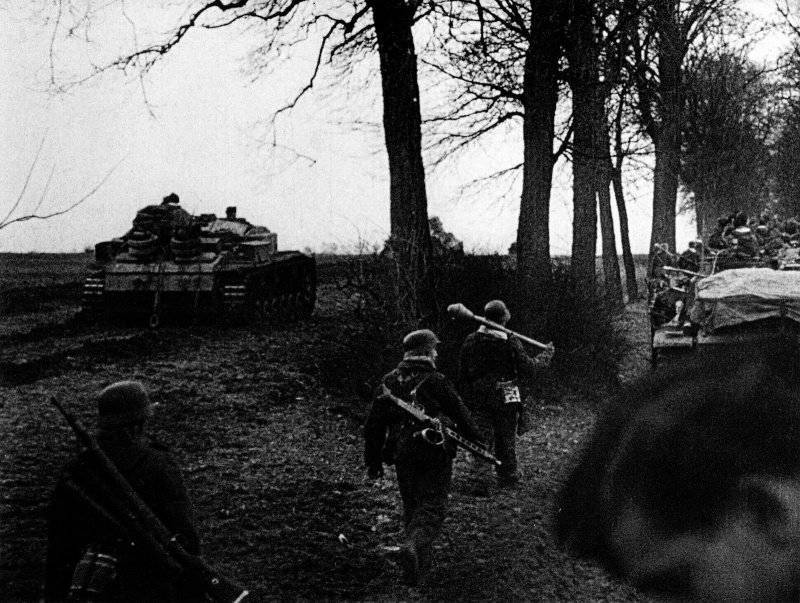
German troops on the march in Pomerania
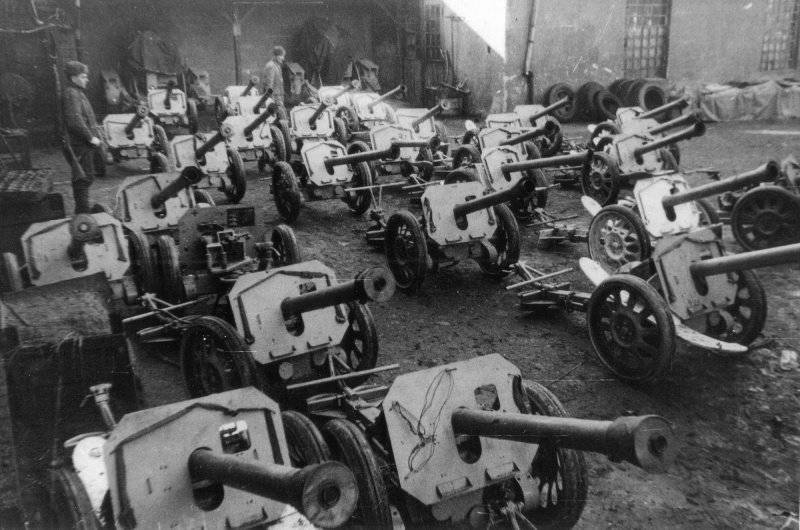
German machine gun 88-mm Puphen anti-tank grenade launchers (Raketenwerfer 43 "Puppchen"), captured by the Red Army in a town in Pomerania
Soviet forces
At the beginning of the battle, the 2 of the Byelorussian Front had four combined armies — the 2 th shock, the 65 th, the 49 th and the 70 th army, supported by the 2 tank, mechanized and cavalry corps. Later, the front was reinforced by the 19 Army and the 3 Guards Tank Corps. From the air, the offensive was supported by the 4-I Air Army. The front had 45 rifle and 3 cavalry divisions, 3 tank, 1 mechanized and 1 cavalry corps, 1 separate tank brigade and 1 fortified. Total front consisted of more than 560 thousand. People.
Of the troops of the 1 of the Byelorussian Front, six armies took part in the operation - 47, 61, 3, shock, 1, Polish, 1, Guards Tank and 2, Guards Tank armies. From the air, ground troops supported the 6-I Air Army. The front right wing included 27 rifle divisions, 3 cavalry divisions, 4 tank and 2 mechanized corps, 2 separate tank, 1 self-propelled artillery brigades and 1 fortified area. More than 359 thousand people, plus more 75 thousand Polish soldiers (5 infantry divisions, cavalry and tank brigades).
Thus, the Soviet forces (together with the Poles) numbered about 1 million people (78 rifle and cavalry divisions, 5 Polish infantry divisions, 10 mechanized and tank corps, 2 fortified area, etc.).
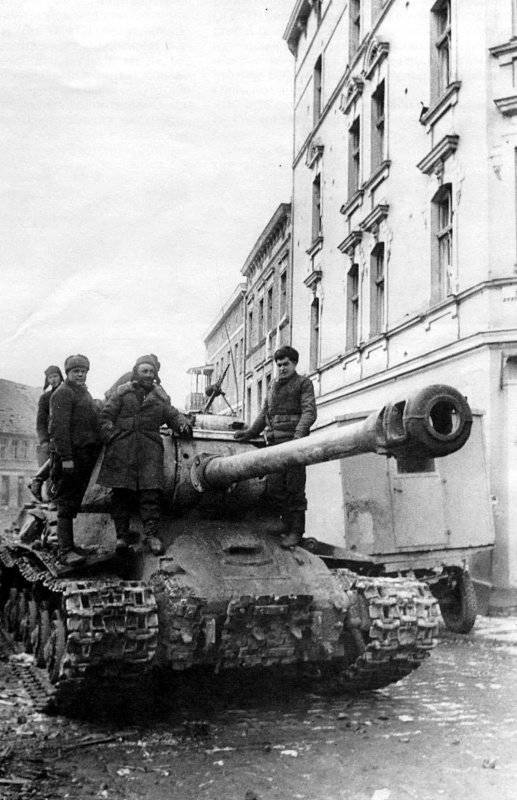
Soviet heavy tank IS-2 on the street of Stargard in Eastern Pomerania
Germanic forces. Defense
Eastern Pomerania was defended by the Army Group "Vistula" under the command of the Reichsführer SS Heinrich Himmler. It consisted of 2-I, 11-I armies, 3-I tank army, which had more than 30 divisions and brigades, including 8 tank divisions and 3 tank brigades. Already in the course of the battle, the number of divisions was brought to 40. In addition, the East Pomeranian group consisted of a significant number of separate regiments and special purpose battalions, brigades, regiments and reinforcement artillery battalions, and militia battalions. On the coast, ground troops were supported by coastal and naval artillery. From the air, ground forces were supported by part of the 6 Air Force (300 machines).
The 2-I field army under the command of Walter Weiss (since March Dietrich von Zauken) held defenses in front of the troops of the 2 of the Belorussian Front. On the left flank defended 20-th, 23-th army corps and corps group "Rappard". They had positions on the banks of the Nogat and Vistula rivers, and also held the Graudenz fortress. In the center and on the right flank, defended parts of the 27 Army, 46 Tank and 18 Mountain Corps. In the first echelon there were up to 12 divisions, in the second, including reserves, 4-6 divisions.
Anton Grasser's 11 Army (the newly formed SS Panzer 11 Army, the army of the 1 Army was killed in the Crimea) defended the forces of the right wing of the Belarus Front 1. It consisted of formations of the 2 Army, 3 and 39 Armored Corps, 10 SS Corps, Tettau corps, two Landwehr and three spare divisions.
In order to strengthen these armies, the German command threw connections into East Pomerania, which had previously held defenses along the rear line on the Oder from Stetta Bay to Schwedt. From East Prussia to Pomerania, they began to transfer units of the 3 tank army. The 3 Tank Army, 11 Tank Corps and 7 SS Corps, which were in reserve of Army Group "Vistula", were subordinated to the Army Administration of the 16 Tank Army. The German High Command planned to strengthen the Eastern Pomeranian grouping of the 6 Tank Army, which was being transferred from the Western Front. However, in connection with the aggravation of the situation on the southern flank of the strategic Soviet-German front, the 6 Tank Army was sent to Budapest. In general, the German grouping to 10 February had 10 corps, including 4 tank, united in three armies, two kept the defense in the first line, the third was in reserve.
In addition, in the Soviet rear, surrounded by enemy groups continued resistance: in the area of Schneidemühl - until 3 infantry divisions (about 30 thousand soldiers), in Deutsch-Krone area - about 7 thousand people; Arnswalde - about 2 divisions (20 thousand people). According to Soviet intelligence, the East Pomeranian grouping was strengthened at the expense of the troops in Courland and East Prussia.
Pomerania was a hilly plain covered with forests for a third. The Kashubian and Pomeranian hills, as well as a large number of lakes with narrow defiles between them, rivers and canals, hampered the maneuver of troops in general, and especially mobile ones. Rivers such as the Vistula, Varta and Oder were serious obstacles to the troops. In addition, in February and March, warm, slushy weather set in, which in the conditions of a large number of reservoirs and swampy areas, led to the fact that troops could move only along the roads. As a result, the area in its natural conditions was very convenient for the organization of a solid defense.
Eastern Pomerania had a developed network of railways, highways and unpaved roads. Most of the highways had a hard surface. As communication also used the river and sea routes of communication. Wisla, Oder, Bydgoszcz Canal and r. Warta were usually navigable almost all year round. On the coast there were large ports, especially Danzig, Gdynia and Stettin, which were the bases of the German fleet. Almost all cities and towns were connected by telegraph and telephone lines, including underground ones. This facilitated the maneuver, the transfer of German troops and their communication.
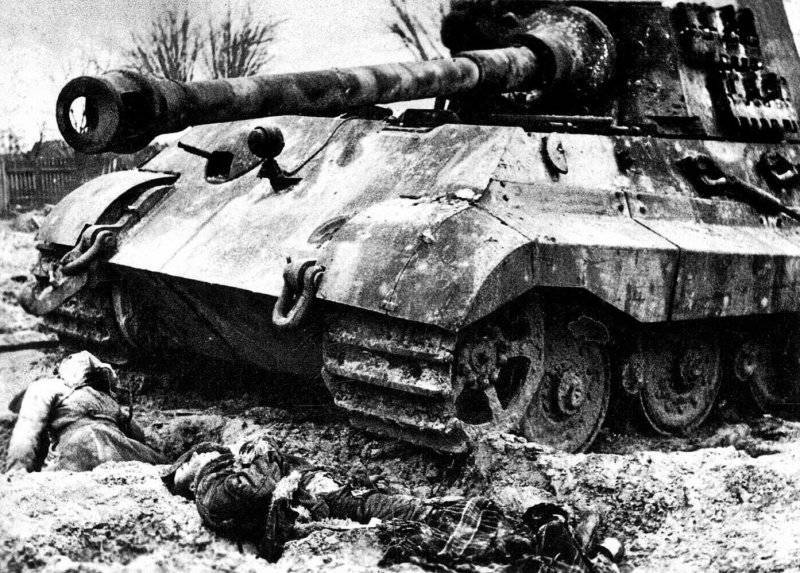
The corpses of the dead soldiers and the padded German tank Pz.Kpfw. VI Ausf. B "Royal Tiger". Pomerania
The Germans were active in equipping fortifications and creating strong strongholds. In these works not only field troops and special organizations participated, but civilians and prisoners. Back in 1933, the Pomeranian Wall was built on the Polish-German border. The left flank of the shaft belonged to the coastal fortifications in the area Shtolpmyunde, then the line went through fortified strongholds Stolp, Rummelsburg, Noyshtettin, Schneidemuhl, Deutsch-Krone (southern part of the shaft was broken by Soviet troops) and is adjacent to the defensive structures on the banks of the Oder and the Warta rivers. The basis of the Pomeranian line was made up of long-term military installations, which defended small garrisons from platoon to company. They were strengthened by field fortifications. Field facilities were covered with a developed system of anti-tank and anti-personnel barriers such as moats, reinforced concrete ridges, minefields and wire lines. A number of cities, including Stolp, Rummelsburg, Neustettin, Schneidemuhl, Deutsch-Krone, were key reference points. They were prepared for a perimeter defense, had a lot of pillboxes and other engineering structures. On the coast there were seaside fortifications - in the area of Danzig, Gdynia, the Hel spit, Loeb, Stolpmünde, Rügenwalde and Kohlberg. There were specially equipped positions of coastal artillery.
Danzig and Gdynia had a defense system built by the front to the south-west. Danzig and Gdynia each had several defense lines, which relied on both long-term structures and field fortifications. The cities themselves were prepared for street fighting. At the beginning of the 1945, the Pomeranian Wall was supplemented by a defensive line along the west bank of the Vistula, from the mouth to the city of Bydgoszcz, with a front to the east and further along the Netze and Warta rivers to Oder, with positions to the south. This defensive line with a depth of 3-5 km consisted of two to five trenches and was reinforced with long-term firing points in the most dangerous areas.
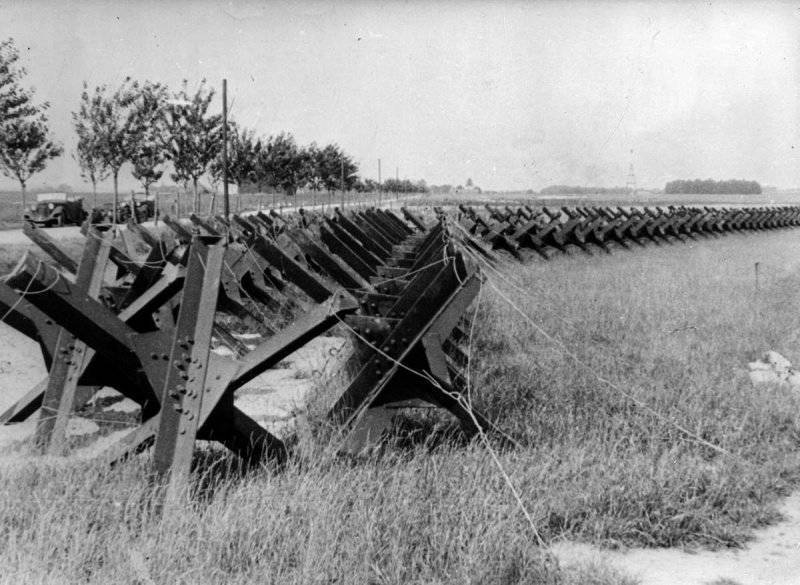
Anti-tank barriers along the road around Danzig
To be continued ...
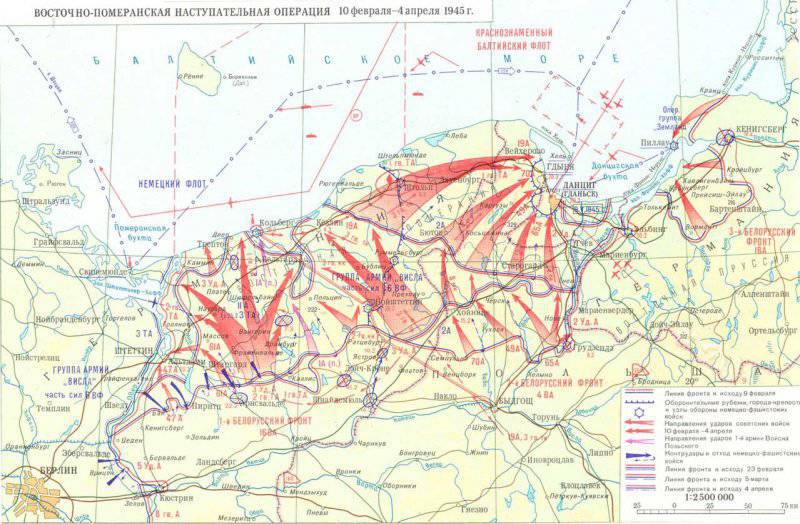
Information